How to Cite | Publication History | PlumX Article Matrix
Andrey Viktorovich Kozlov1, Alexey Stanislavovich Terenchenko2 and Kirill Evgenievich Karpukhin3
1Head of Department, Doctor of Science,
2Director of Centre, Doctor of Philosophy,
3Head of department, Doctor of Philosophy, Federal State Unitary Enterprise Central
Scientific Research Automobile and Automotive Institute “NAMI” (FSUE «NAMI»),
Avtomotornaya Street, 2, Moscow, Russia, 125438.
ABSTRACT: This paper assess different types of electrical energy storage devices used in electric and hybrid vehicles. A rationale is presented for selecting a type of an energy storage device based on multiple criteria. A total life cycle analysis of the energy storage as part of an electric vehicle or hybrid electric vehicleis carried out.
KEYWORDS: energy storage; battery; supercapacitor; total life cycle; energy consumption; emissions, energy efficiency
Download this article as:| Copy the following to cite this article: Kozlov A. V, Terenchenko A. S, Karpukhin K. E. Comparative Analysis of Different Types of Energy Storage Devices for Motor Vehicles With Regard to their Total Life Cycle. Biosci Biotech Res Asia 2015;12(2) |
Introduction
When creating vehicles with a hybridpower plant or an electric vehicle, the choice of the energy storage device type is one of the key issues. Currently, lithium-polymer and NiMH batteries are most widely used and lead-acid batteries are less common. In recent years there has been a considerable progress in the development of supercapacitors, which have significantly greater service life than existing types of batteries. Each of these types of energy storage devices has certain advantages and disadvantages, making a clear choice impossible. Therefore, it is necessary to justify the choice of the energy storage type basing on a number of different criteria. Such a selection process is best done on the basis of the energy storage total life cycle analysis in electric vehicle or a hybrid power plant. (Bahmutov and Karpukhin, 2012;Beyer, 1997;Kaniut et al., 1997;Franze and Neumann, 1997)
The total life cycle of a battery is understood as the sequence of the following stages: extraction of natural resources, manufacture of components, assembling the battery and its installation into the vehicle, operation as part of the vehicle and disposal. The analysis of the total life cycle (TLC) is done taking into account the consumption of natural resources and energy, emissions of harmful substances, and integrated assessment of the negative environmental impact.
The main part
In this study, the evaluation was carried out using mathematical models and techniques, developed by FSUE “NAMI” in total accordance with international standards ISO 14040 – 14043.(Zvonov et al., 2001;Heijungs et al., 1992;Schuckert et al., 1997)
To assess TLC on the basis of domestic and international experience in creation of hybrid power plants or electric vehicles we chose four types of electrical energy storage devices:
- lithium-polymer batteries (Li-pol);
- nickel-metal hydride rechargeable batteries (Ni-MH);
- lead-acid batteries (Lead-Acid);
- supercapacitors (Ultracap).
Analysis of the data from the world’s leading manufacturers of batteries and supercapacitors (Longoet al., 2014; Zackrisson et al., 2010;Van den Bossche et al., 2006;Catelani et al., 2013;Hutchinson et al., 2014;Balestrini and Levizzari, 1997;Coulson and Stobart, 2000;Gaines and Cuenca, 2000;Ishihara at al., 1999;Osamu, 1997) made it possible to determine the main technical characteristics of the energy storage, required for the calculations presented in Table 1.
Table 1: Main technical characteristics of electric energy storage devices
| Indicator | Sample 1
Li-pol |
Sample 2
Ni-MH |
Sample 3
Lead-Acid |
Sample 4
Ultracap |
| Specific energy consumption, Wh/kg | 100 | 65 | 35 | 5,68 |
| Service life, years | 3,5 | 2,5 | 3,5 | 10 |
| Efficiency | 0,99 | 0,91 | 0,9 | 0,99 |
To evaluate the storage performance at the production stage we checked the average composition of the materials used for different types of energy storage, basing on the manufacturers’ data analysis (Table. 2-5).
Table 2: Average composition of materials used to produce lithium-polymer batteries
| Material | Weight% |
| Lithium oxide (LiO2) | 5,3% |
| Nickel | 2,6% |
| Cobalt | 2,7% |
| Magnesium | 2,5% |
| Graphite | 10,6% |
| Copper | 24,5% |
| Aluminum | 29,2% |
| Electrolyte | 8,7% |
| Plastic | 13,1% |
| Steel | 0,2% |
| Thermal insulation material | 0,5% |
| Electronic Components | 0,1% |
Table 3: Average composition of materials used to produce lead-acid batteries
| Material | Weight% |
| Plastic | 6,1% |
| Lead | 69,0% |
| Sulfuric acid | 7,9% |
| Glasswool | 2,1% |
| Water | 14,1% |
| Others | 0,8% |
Table 4: Average composition of materials used to produce NiMH batteries
| Material | Weight% |
| Steel | 35,7% |
| Aluminum | 0,5% |
| Copper | 3,9% |
| Magnesium | 1,0% |
| Cobalt | 1,8% |
| Nickel | 28,2% |
| Rare earth metals | 6,3% |
| Plastic | 22,5% |
| Rubber | 0,1% |
Table 5: Average composition of materials used to produce supercapacitors
| Material | Weight% |
| Nickel | 5,3% |
| Magnesium | 2,5% |
| Graphite | 11,7% |
| Copper | 22,5% |
| Aluminum | 29,8% |
| Electrolyte | 14,0% |
| Plastic | 13,1% |
| Thermal insulation material | 0,5% |
| Electronic Components | 0,6% |
Consumption of energy/natural resources and emissions of pollutants during production of the reviewed types of energy storage are shown in Table 6.
Table 6: Consumption of energy, natural resources and emissions of pollutants during the production of the reviewed types of energy storage devices
| Indicator | Sample 1 | Sample 2 | Sample 3 | Sample 4 |
| Li-pol | Ni-MH | Lead-Acid | Ultracap | |
| Energy consumption, MJ | ||||
| Total | 85227,5 | 97835,3 | 76285,4 | 86449,4 |
| non-renewable resources | 74427,8 | 85437,9 | 66618,8 | 75494,8 |
| Coal | 52796,3 | 60606,6 | 47256,9 | 53553,3 |
| Natural gas | 17907,6 | 20556,7 | 16028,7 | 18164,3 |
| Oil | 3723,8 | 4274,7 | 3333,1 | 3777,2 |
| Emissions, g | ||||
| CH | 603,9 | 693,3 | 540,6 | 612,6 |
| CO | 1793,8 | 2059,1 | 1605,6 | 1819,5 |
| NOx | 7352,4 | 8440,1 | 6581,0 | 7457,9 |
| PM10 | 8888,4 | 10203,3 | 7955,9 | 9015,9 |
| PM2.5 | 2341,0 | 2687,3 | 2095,4 | 2374,5 |
| SOx | 16181,3 | 18575,0 | 14483,5 | 16413,2 |
| CH4 | 9085,2 | 10429,2 | 8132,0 | 9215,4 |
| N2O | 95,5 | 109,6 | 85,5 | 96,8 |
| CO2 | 6747404,0 | 7745553,7 | 6039465,2 | 6844141,0 |
A total life cycle study of the indicators of different types of energy storage devices installed in the minibus “Next” was conducted. The main characteristics of the vehicle and its energy storage system, required for the calculations, are presented in Table 7.
Table 7: Main characteristics of the minibus vehicle Next and its energy storage systems
| Indicator | Value |
| Service life, years | 5 |
| Mileage per year, km | 50000 |
| Number of battery modules (for Li-pol) | 14 |
| Battery capacity, Wh | 35000 |
Basing on the data in Tables 1 and 7 and the need to ensure sufficient run length on electric drive (without using ICE) of about 25…30 km we determined the weight of energy storage systems of different types for the Next minibus and the number of battery sets for the TLC of the vehicle (Table 8).
Table 8:Weight of energy storage systems of different types and the number of battery sets for TLC
| Battery | Weight, kg | Number of sets, pieces |
| Sample 1, Li-pol | 350 | 2 |
| Sample 2, Ni-MH | 538 | 2 |
| Sample 3, Lead-Acid | 1000 | 2 |
| Sample 4, Ultracap | 6162 | 1 |
At the production stage, we took into account the material (natural resources, emissions of pollutants and greenhouse gases) and energy flows, which exist in the manufacturing process of structural materials in order to produce the energy storage units and assemble them.
At the operation stage we took into account energy losses and emissions caused by losses during the charge-discharge cycle and losses due to increased vehicle weight after installation of the energy storage device.
Consumption of non-renewable natural resources, energy consumption, emissions of polluting substances and greenhouse gases for the four types of electrical energy storage devices in the hybrid power plant of the Next minibus are shown in Figures 1 – 4.
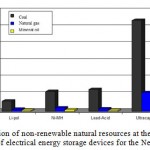 |
Figure 1: Consumption of non-renewable natural resources at the production stage of the four types of electrical energy storage devices for the Next minibus (kg) |
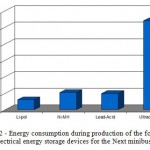 |
Figure 2: Energy consumption during production of the four types of electrical energy storage devices for the Next minibus (MJ) |
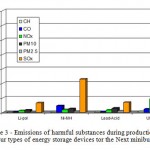 |
Figure 3: Emissions of harmful substances during production of the four types of energy storage devices tor the Next minibus (kg) |
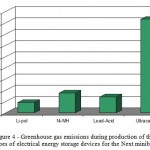 |
Figure 4: Greenhouse gas emissions during production of the four types of electrical energy storage devices for the Next minibus (kg) |
Simulation of the Next minibus motion was done in accordance with the urban test cycle of UNECE Regulation #83, using AVL Cruise software.
Additional energy consumption – the energy cost of driving with increase vehicle weight due to the added battery weight, heat losses during charging and discharging the battery, equivalent diesel fuel consumption due to additional energy consumption, additional emissions and greenhouse gas (caused by increased fuel consumption ) for the four types of electrical energy storage devices while operating the Next minibus are presented in Figures 5-8.
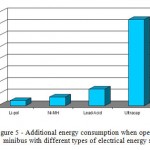 |
Figure 5: Additional energy consumption when operating the Next minibus with different types of electrical energy storage (MJ) |
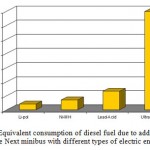 |
Figure 6: Equivalent consumption of diesel fuel due to additional energy use when operating the Next minibus with different types of electric energy storage devices (kg) |
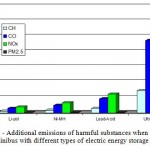 |
Figure 7: Additional emissions of harmful substances when operating the Next minibus with different types of electric energy storage devices (kg) |
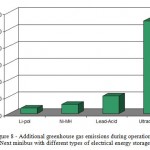 |
Figure 8: Additional greenhouse gas emissions during operation of the Next minibus with different types of electrical energy storage (kg) |
Figures 9 – 12 show the results of the energy consumption calculation, emissions of harmful substances and greenhouse gases as well as environmental damage (Vershkov et al., 1999;Goedkoop and Spriensma, 2000) for the total life cycleof the different types of electrical energy storage devices operated as parts of the hybrid power plant of the Next minibus.
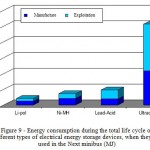 |
Figure 9: Energy consumption during the total life cycle of different types of electrical energy storage devices, when they are used in the Next minibus (MJ) |
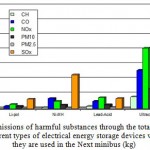 |
Figure 10: Emissions of harmful substances through the total life cycle of different types of electrical energy storage devices when they are used in the Next minibus (kg) |
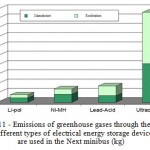 |
Figure 11: Emissions of greenhouse gases through the total life cycle of different types of electrical energy storage devices when they are used in the Next minibus (kg) |
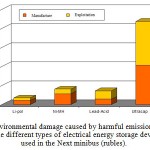 |
Figure 12: Environmental damage caused by harmful emissions through the total life cycle of the different types of electrical energy storage devices when they are used in the Next minibus (rubles). |
Conclusions
Thus, the results of the comparative TLC assessment of the different types of electrical energy storage devices, provided their application in the Next minibus, show that:
- Lithium-ion batteries show the smallest energy consumption for the TLC. The same for NiMH is 1.7 times higher, for lead-acid it is 2.27 times higher, and for supercapacitors it is 12.1 times higher.
- Lithium-ion electric energy storage has the lowest total consumption of non-renewable natural resources for TLC. The same for NiMH is 1.85 times higher, for lead-acid it is 1.87 times higher, for supercapacitors it is 8.83 times higher.
- Lithium-ion electric energy storage has the lowest gross emissions of pollutants through TLC. The same for NiMH is 2.85 times higher, for lead-acid it is up to 1.79 times higher and for supercapacitors it is 11.6 times higher.
- Lithium-ion electric energy storage has the lowest emissions of greenhouse gases through TLC. The same for NiMH is 1.8 times higher, for lead-acid it is 2.21 times higher, for supercapacitors it is 12.07 times higher.
- The environmental damage from emissions and greenhouse gas through TLC is the lowest for lithium-ion electric energy storage systems. The same for NiMH is 2.28 times higher, for lead-acid it is 2.06 times higher, for supercapacitors it is 12.3 times higher.
- In further studies of the total life cycle of energy storage devices, it will also be necessary to take into account the energy consumption and pollution issues at the stage of disposal for different types of energy storage.
Acknowledgments
The paper was prepared under the agreement # 14.625.21.0006 with the Ministry of Education and Science of the Russian Federation (unique project identifier RFMEFI62514X0006) to create an experimental model of an environmentally friendly electric vehicle.
References
- Longo S., Antonucci V., Cellura M., Ferraro M. (2014). Life cycle assessment of storage systems: the case study of a sodium/nickel chloride battery.Journal of Cleaner Production, 85 (337-346).
- ZackrissonM., AvellánL., OrleniusJ.,(2010), Life cycle assessment of lithium-ion batteries for plug-in hybrid electric vehicles – Critical issues. Journal of Cleaner Production, 18, Issue 15 (1519-1529).
- Van den BosscheP., VergelsF., Van MierloJ., MatheysJ., Van AutenboerW.,(2006), SUBAT: An assessment of sustainable battery technology.Journal of Power Sources, 162, Issue 2 (913-919).
- CatelaniM., CianiL., MarracciM., TelliniB.,(2013),Analysis of ultracapacitors ageing in automotive application.Microelectronics Reliability, 53, Issues 9–11 (1676-1680).
- HutchinsonT., BurgessS., HerrmannG.,(2014),Current hybrid-electric powertrain architectures: Applying empirical design data to life cycle assessment and whole-life cost analysis. Applied Energy, 119, (314-329).
- Bahmutov S.V., Karpukhin K.E., (2012),“Pure” cars: the directions of realization and reached results.Zhurnal avtomobil’nyh inzhenerov, 6 (77), (51-54).
- Zvonov V.A., Kozlov A.V., Kutenev V.F. (2001).Vehicle environmental performances in total life cycle.Moscow: NAMI.
- FranzeH.A., NeumannU.,(1997),Design for environmental compatibility of automobiles – new life-cycle management tools in the BMW product development process.SAE paper, 971192 (53-62).
- VershkovL.V., GroshevV.L., Gavrilov V.V. et al. (1999).Vremennaja metodika opredelenija predotvrashhennogo jekologicheskogo ushherba. Мoscow.
- BalestriniA., LevizzariA., (1997), An Application of Life-Cycle Analysis on the Electric Vehicle Car.SAE paper, 971179 (9).
- BeyerH.M., (1997), Life Cycle Assessment – Combined Efforts of the European Automotive Industry.SAE paper, 971172(10).
- CoulsonG.,StobartR., (2000), Life-Cycle Analysis and the Fuel Cell Car.SAE paper,2000-01-1485 (4).
- HeijungsR., GuinéeJ.B., Huppes G.et al. (1992).Environmental life cycle assessment of products. Leiden: CML.
- GainesL., CuencaR.,(2000),Life-Cycle Costs of Lithium-Ion Vehicle Batteries.SAE paper, 2000-01-1483 (12).
- GoedkoopM., SpriensmaR..(2000). The Eco-indicator 99. A damage oriented method for Life Cycle Impact Assessment. Methodology Report. Amersfoort (NL): PRé consultants, (142).
- GoedkoopM., SpriensmaR., (2000), The Eco-indicator 99. A damage oriented method for Life Cycle Impact Assessment. Methodology Annex.Amersfoort (NL): PRé consultants,(87).
- IshiharaK., NishimuraK., UchiyamaY., (1999),Lifecycle Analysis of Electric Vehicles with Advanced Batteries in Japan. EV-Clean Driving into the 21st Century. Beijing.
- SchuckertM., BeddiesH., Gediga J.et al., (1997), Life Cycle Inventories – New Experiences to Save Environmental Loads and Costs.SAE paper,971171 (6).
- OsamuK.O..(1997), Car Life Cycle Inventory Assessment.SAE paper,971199 (9).
- 20. KaniutC., CetinerH., FranzeckJ., (1997),Life Cycle Assessment of a Complete Car – The Mercedes-Benz Approach. SAE paper, 971166(8).

This work is licensed under a Creative Commons Attribution 4.0 International License.





